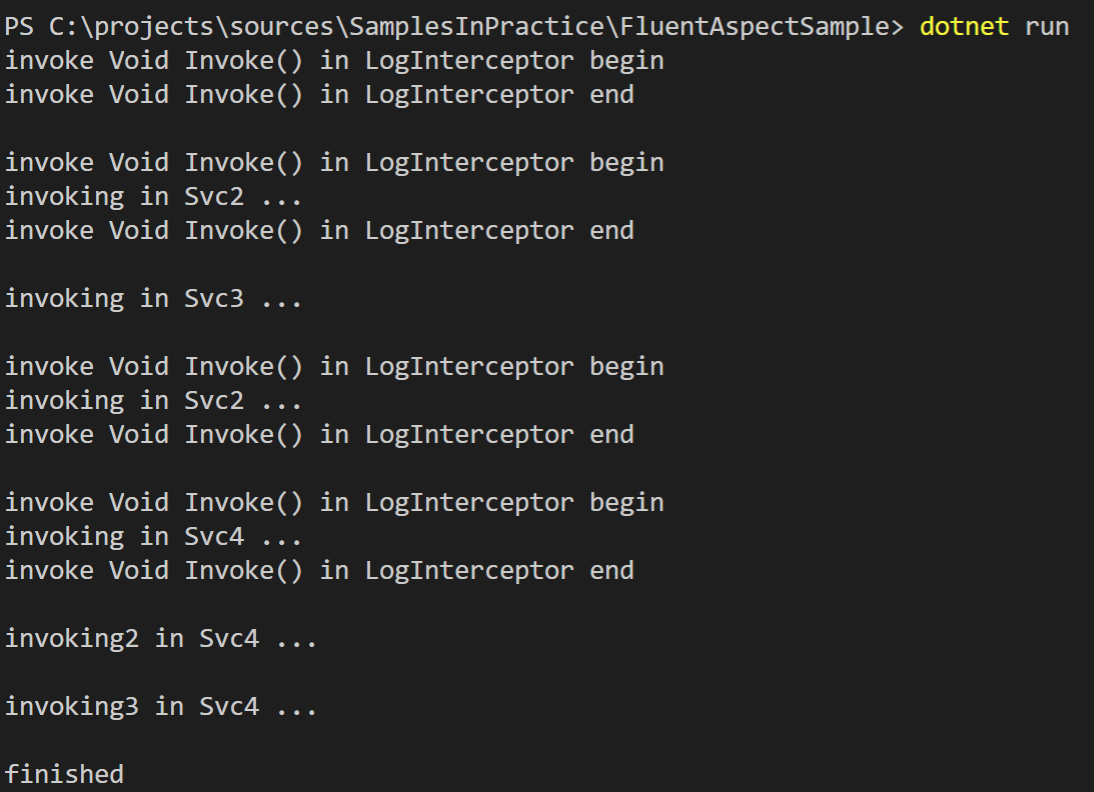FluentAspects -- 基于 Fluent API 的 Aop
Intro
上次我们做了一个简单的 AOP 实现示例,但是实现起来主要是基于 Attribute 来做的,对于代码的侵入性太强,于是尝试实现基于 Fluent API 的方式来做 AOP 。
抽象 InterceptorResolver
原来获取方法执行的 Interceptor 是通过 Attribute 来获取的,现在我们只需要将获取 Interceptor 的逻辑抽象出来就可以实现不必依赖于 Attribute 了
方法执行上下文定义:
public interface IInvocation
{
public MethodInfo ProxyMethod { get; }
public object ProxyTarget { get; }
public MethodInfo Method { get; }
public object Target { get; }
public object[] Arguments { get; }
Type[] GenericArguments { get; }
public object ReturnValue { get; set; }
}
方法拦截器 Interceptor 接口定义:
public interface IInterceptor
{
Task Invoke(IInvocation invocation, Func<Task> next);
}
自定义 Interceptor 只需要继承这个接口实现相应的逻辑就好了
获取 IInterceptorResolver 接口定义:
public interface IInterceptorResolver
{
IReadOnlyCollection<IInterceptor> ResolveInterceptors(IInvocation invocation);
}
原来基于 Attribute 获取 Interceptor 的方式可以实现一个 AttributeInterceptorResolver
想要基于 Fluent API 来获取 Interceptor ,只需要实现基于 Fluent API 的 InterceptorResolver 就可以了,具体的实现可以参考 FluentConfigInterceptorResolver
示例预览
测试服务定义:
public interface ISvc1
{
void Invoke();
}
public interface ISvc2
{
void Invoke();
}
public class Svc2 : ISvc2
{
public void Invoke()
{
Console.WriteLine($"invoking in {GetType().Name} ...");
}
public void Invoke2()
{
Console.WriteLine($"invoking in {GetType().Name} ...");
}
}
public class Svc3
{
public virtual void Invoke()
{
Console.WriteLine($"invoking in {GetType().Name} ...");
}
}
public class Svc4
{
public virtual void Invoke()
{
Console.WriteLine($"invoking in {GetType().Name} ...");
}
public void Invoke2()
{
Console.WriteLine($"invoking2 in {GetType().Name} ...");
}
public virtual void Invoke3()
{
Console.WriteLine($"invoking3 in {GetType().Name} ...");
}
}
测试 Interceptor
internal class LogInterceptor : IInterceptor
{
public async Task Invoke(IInvocation invocation, Func<Task> next)
{
Console.WriteLine($"invoke {invocation.ProxyMethod} in {GetType().Name} begin");
await next();
Console.WriteLine($"invoke {invocation.ProxyMethod} in {GetType().Name} end");
}
}
测试代码:
public static void Main(string[] args)
{
var services = new ServiceCollection();
services.AddFluentAspects(options =>
{
// 为所有拦截的方法添加拦截器
options.InterceptAll()
.With<LogInterceptor>()
;
// 对 Svc3 类型禁用拦截器
options.NoInterceptType<Svc3>();
// Svc4 类型的 Invoke3() 方法禁用拦截器
options.NoInterceptMethod<Svc4>(s => s.Invoke3());
});
services.AddTransientProxy<Svc4>();
var serviceProvider = services.BuildServiceProvider();
var proxyFactory = serviceProvider.GetRequiredService<IProxyFactory>();
var svc1 = proxyFactory.CreateProxy<ISvc1>();
svc1.Invoke();
Console.WriteLine();
var svc2 = proxyFactory.CreateProxy<ISvc2, Svc2>();
svc2.Invoke();
Console.WriteLine();
var svc3 = proxyFactory.CreateProxy<Svc3>();
svc3.Invoke();
Console.WriteLine();
var svc4 = proxyFactory.CreateProxyWithTarget<ISvc2, Svc2>(new Svc2());
svc4.Invoke();
Console.WriteLine();
// 直接从注册的服务中获取
var svc5 = serviceProvider.GetRequiredService<Svc4>();
svc5.Invoke();
Console.WriteLine();
svc5.Invoke2();
Console.WriteLine();
svc5.Invoke3();
Console.WriteLine();
Console.WriteLine("finished");
Console.ReadLine();
}
输出结果预览:

More
最近十几天的时间一直在搞这个,相比之前写的示例,真正实现一个完整的 AOP 框架还是要做比较多的事情的,之前的 AOP 示例,没有考虑泛型,也没有什么设计,所以前面的示例只能算是一个小玩具。
在实现的过程中,参考了很多 AspectCore 的代码,有一些代码甚至是直接从 AspectCore 里抄过来的。
推荐大家有机会研究学习一下柠檬大佬的 AspectCore 的源码,这个 AOP 框架的代码组织,代码细节都挺不错的。
AspectCore 源码地址: https://github.com/dotnetcore/AspectCore-Framework